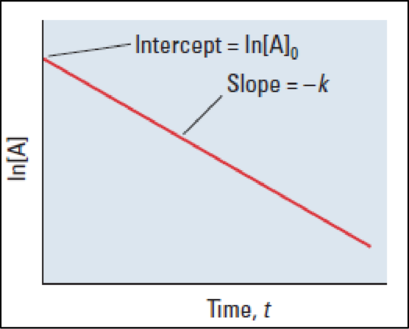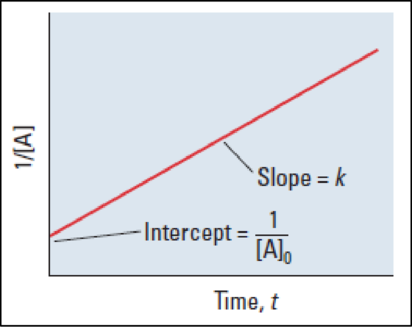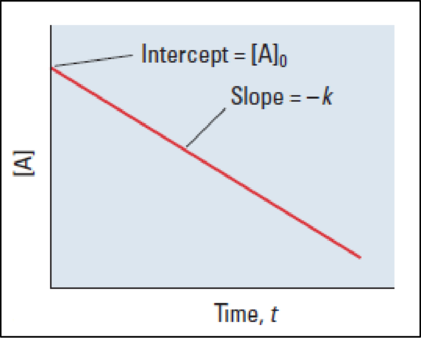
Bundle: Chemistry: The Molecular Science, 5th, Loose-Leaf + OWLv2 with Quick Prep 24-Months Printed Access Card
5th Edition
ISBN: 9781305367487
Author: John W. Moore, Conrad L. Stanitski
Publisher: Cengage Learning
expand_more
expand_more
format_list_bulleted
Question
Chapter 11.3, Problem 11.5PSP
Interpretation Introduction
Interpretation:
The order of the reaction with respect to
Concept Introduction:
First-order reaction plot:
The slope of the first-order plot gives the value of first order rate constant.

Figure 1
Second-order reaction plot:

Figure 2
Zero-order reaction plot:

Figure 3
Expert Solution & Answer
Want to see the full answer?
Check out a sample textbook solution
Students have asked these similar questions
please provide the structure for this problem, thank you!
Draw the Fischer projection from the skeletal
structure shown below.
HO
OH
OH
OH
OH H
Q
Drawing
Atoms, Bonds
and Rings
Charges
I
☐
T
HO
H
H
OH
HO
I
CH2OH
H
OH
Drag
H
OH
-CH2OH
CHO
-COOH
Undo
Reset
Remove
Done
please provide the structure for this problem, thank you
Chapter 11 Solutions
Bundle: Chemistry: The Molecular Science, 5th, Loose-Leaf + OWLv2 with Quick Prep 24-Months Printed Access Card
Ch. 11.1 - For the reaction of crystal violet with NaOH(aq),...Ch. 11.1 - (a) From data in Table 11.1, calculate the rate of...Ch. 11.1 - For the reaction 4NO2(g)+O2(g)2N2O5(g) (a) express...Ch. 11.1 - Instantaneous rates for the reaction of hydroxide...Ch. 11.1 - Prob. 11.3CECh. 11.2 - Prob. 11.4ECh. 11.2 - Prob. 11.3PSPCh. 11.2 - Prob. 11.5ECh. 11.3 - Prob. 11.4PSPCh. 11.3 - Prob. 11.5PSP
Ch. 11.3 - Prob. 11.6PSPCh. 11.3 - Prob. 11.7PSPCh. 11.4 - Prob. 11.6ECh. 11.4 - Prob. 11.7CECh. 11.4 - Prob. 11.8PSPCh. 11.4 - Prob. 11.8CECh. 11.5 - Prob. 11.9PSPCh. 11.5 - The frequency factor A is 6.31 108 L mol1 s1 and...Ch. 11.6 - Prob. 11.10CECh. 11.7 - Prob. 11.11ECh. 11.7 - The Raschig reaction produces the industrially...Ch. 11.7 - Prob. 11.12ECh. 11.8 - The oxidation of thallium(I) ion by cerium(IV) ion...Ch. 11.9 - Prob. 11.11PSPCh. 11.9 - Prob. 11.14CECh. 11 - An excellent way to make highly pure nickel metal...Ch. 11 - Prob. 1QRTCh. 11 - Prob. 2QRTCh. 11 - Prob. 3QRTCh. 11 - Prob. 4QRTCh. 11 - Prob. 5QRTCh. 11 - Prob. 6QRTCh. 11 - Prob. 7QRTCh. 11 - Prob. 8QRTCh. 11 - Prob. 9QRTCh. 11 - Prob. 10QRTCh. 11 - Prob. 11QRTCh. 11 - Cyclobutane can decompose to form ethylene:
The...Ch. 11 - Prob. 13QRTCh. 11 - Prob. 14QRTCh. 11 - For the reaction 2NO2(g)2NO(g)+O2(g) make...Ch. 11 - Prob. 16QRTCh. 11 - Prob. 17QRTCh. 11 - Ammonia is produced by the reaction between...Ch. 11 - Prob. 19QRTCh. 11 - Prob. 20QRTCh. 11 - The reaction of CO(g) + NO2(g) is second-order in...Ch. 11 - Nitrosyl bromide, NOBr, is formed from NO and Br2....Ch. 11 - Prob. 23QRTCh. 11 - Prob. 24QRTCh. 11 - Prob. 25QRTCh. 11 - For the reaction
these data were obtained at 1100...Ch. 11 - Prob. 27QRTCh. 11 - Prob. 28QRTCh. 11 - Prob. 29QRTCh. 11 - Prob. 30QRTCh. 11 - Prob. 31QRTCh. 11 - Prob. 32QRTCh. 11 - For the reaction of phenyl acetate with water the...Ch. 11 - When phenacyl bromide and pyridine are both...Ch. 11 - The compound p-methoxybenzonitrile N-oxide, which...Ch. 11 - Prob. 36QRTCh. 11 - Radioactive gold-198 is used in the diagnosis of...Ch. 11 - Prob. 38QRTCh. 11 - Prob. 39QRTCh. 11 - Prob. 40QRTCh. 11 - Prob. 41QRTCh. 11 - Prob. 42QRTCh. 11 - Prob. 43QRTCh. 11 - Prob. 44QRTCh. 11 - Prob. 45QRTCh. 11 - Prob. 46QRTCh. 11 - Prob. 47QRTCh. 11 - Prob. 48QRTCh. 11 - Prob. 49QRTCh. 11 - Prob. 50QRTCh. 11 - Prob. 51QRTCh. 11 - Prob. 52QRTCh. 11 - For the reaction of iodine atoms with hydrogen...Ch. 11 - Prob. 54QRTCh. 11 - The activation energy Ea is 139.7 kJ mol1 for the...Ch. 11 - Prob. 56QRTCh. 11 - Prob. 57QRTCh. 11 - Prob. 58QRTCh. 11 - Prob. 59QRTCh. 11 - Prob. 60QRTCh. 11 - Prob. 61QRTCh. 11 - Prob. 62QRTCh. 11 - Prob. 63QRTCh. 11 - Which of the reactions in Question 62 would (a)...Ch. 11 - Prob. 65QRTCh. 11 - Prob. 66QRTCh. 11 - Prob. 67QRTCh. 11 - Prob. 68QRTCh. 11 - Prob. 69QRTCh. 11 - Prob. 70QRTCh. 11 - Prob. 71QRTCh. 11 - For the reaction the rate law is Rate=k[(CH3)3CBr]...Ch. 11 - Prob. 73QRTCh. 11 - Prob. 74QRTCh. 11 - Prob. 75QRTCh. 11 - For this reaction mechanism,
write the chemical...Ch. 11 - Prob. 77QRTCh. 11 - Prob. 78QRTCh. 11 - Prob. 79QRTCh. 11 - When enzymes are present at very low...Ch. 11 - Prob. 81QRTCh. 11 - The reaction is catalyzed by the enzyme succinate...Ch. 11 - Prob. 83QRTCh. 11 - Many biochemical reactions are catalyzed by acids....Ch. 11 - Prob. 85QRTCh. 11 - Prob. 86QRTCh. 11 - Prob. 87QRTCh. 11 - Prob. 88QRTCh. 11 - Prob. 89QRTCh. 11 - Prob. 90QRTCh. 11 - Prob. 91QRTCh. 11 - Prob. 92QRTCh. 11 - Prob. 93QRTCh. 11 - Prob. 94QRTCh. 11 - Nitryl fluoride is an explosive compound that can...Ch. 11 - Prob. 96QRTCh. 11 - Prob. 97QRTCh. 11 - For a reaction involving the decomposition of a...Ch. 11 - Prob. 99QRTCh. 11 - Prob. 100QRTCh. 11 - Prob. 101QRTCh. 11 - This graph shows the change in concentration as a...Ch. 11 - Prob. 103QRTCh. 11 - Prob. 104QRTCh. 11 - Prob. 105QRTCh. 11 - Prob. 106QRTCh. 11 - Prob. 107QRTCh. 11 - Prob. 108QRTCh. 11 - Prob. 109QRTCh. 11 - Prob. 110QRTCh. 11 - Prob. 111QRTCh. 11 - Prob. 112QRTCh. 11 - Prob. 113QRTCh. 11 - Prob. 114QRTCh. 11 - Prob. 115QRTCh. 11 - Prob. 116QRTCh. 11 - Prob. 118QRTCh. 11 - Prob. 119QRTCh. 11 - In a time-resolved picosecond spectroscopy...Ch. 11 - If you know some calculus, derive the integrated...Ch. 11 - If you know some calculus, derive the integrated...Ch. 11 - (Section 11-5) A rule of thumb is that for a...Ch. 11 - Prob. 11.BCPCh. 11 - Prob. 11.CCPCh. 11 - Prob. 11.DCP
Knowledge Booster
Learn more about
Need a deep-dive on the concept behind this application? Look no further. Learn more about this topic, chemistry and related others by exploring similar questions and additional content below.Similar questions
- presented by Morallen Lig Intermine the hand product for the given mution by adding atoms, bonds, nonhonding diarion panda скуль Step 3: Comp the draw the product Step 2: Agama workup Compithe 429 ملولةarrow_forwardReaction A 0,0arrow_forwardpresented by Morillon Leaning Predict the organic product for the min кусур HSC Adithane carved arnown to come than that to the condon slchroruis in acid in in aquishri with ноюarrow_forward
- 6.15PM Sun Mar 30 K Draw the major product of this reaction. Include any relevant stereochemistry. Ignore inorganic byproducts. Problem 1 of O H [PhзPCH2CH3]*C|¯ NaH Drawing > Q Atoms, Bonds and Draw or tap a nearrow_forward8:17 PM Sun Mar 30 Draw the major product of this reaction. Ignore inorganic byproducts. HSCH2CH2CH2SH, BF3 Probler Drawing Ato Bonds Clarrow_forwardpresented by Mr L How the coprion. (Il Done in no wraction, dew the starting redential) доarrow_forward
- 8:16 PM Sun Mar 30 K Draw the major product of this reaction. Ignore inorganic byproducts. Proble 1. CH3MgBr 2. H3O+ F Drawingarrow_forwardо но оarrow_forwardName the major organic product of the following action of 4-chloro-4-methyl-1-pentanol in neutral pollution 10+ Now the product. The product has a molecular formula f b. In a singly hain, the starting, material again converts into a secule with the molecular kormula CIO. but with comply Draw the major organic structure inhalationarrow_forward
- Macmillan Learning Alcohols can be oxidized by chromic acid derivatives. One such reagent is pyridinium chlorochromate, (C,H,NH*)(CICTO3), commonly known as PCC. Draw the proposed (neutral) intermediate and the organic product in the oxidation of 1-butanol by PCC when carried out in an anhydrous solvent such as CH₂C₁₂. PCC Intermediate OH CH2Cl2 Draw the intermediate. Select Draw Templates More с H Cr о Product Draw the product. Erase Select Draw Templates More H о Erasearrow_forwardIf I have 1-bromopropene, to obtain compound A, I have to add NaOH and another compound. Indicate which compound that would be. A C6H5 CH3arrow_forwardProvide the reagents for the following reactions.arrow_forward
arrow_back_ios
SEE MORE QUESTIONS
arrow_forward_ios
Recommended textbooks for you
 Chemistry: The Molecular ScienceChemistryISBN:9781285199047Author:John W. Moore, Conrad L. StanitskiPublisher:Cengage Learning
Chemistry: The Molecular ScienceChemistryISBN:9781285199047Author:John W. Moore, Conrad L. StanitskiPublisher:Cengage Learning ChemistryChemistryISBN:9781305957404Author:Steven S. Zumdahl, Susan A. Zumdahl, Donald J. DeCostePublisher:Cengage Learning
ChemistryChemistryISBN:9781305957404Author:Steven S. Zumdahl, Susan A. Zumdahl, Donald J. DeCostePublisher:Cengage Learning Chemistry: An Atoms First ApproachChemistryISBN:9781305079243Author:Steven S. Zumdahl, Susan A. ZumdahlPublisher:Cengage Learning
Chemistry: An Atoms First ApproachChemistryISBN:9781305079243Author:Steven S. Zumdahl, Susan A. ZumdahlPublisher:Cengage Learning Chemistry: Matter and ChangeChemistryISBN:9780078746376Author:Dinah Zike, Laurel Dingrando, Nicholas Hainen, Cheryl WistromPublisher:Glencoe/McGraw-Hill School Pub Co
Chemistry: Matter and ChangeChemistryISBN:9780078746376Author:Dinah Zike, Laurel Dingrando, Nicholas Hainen, Cheryl WistromPublisher:Glencoe/McGraw-Hill School Pub Co Chemistry for Engineering StudentsChemistryISBN:9781337398909Author:Lawrence S. Brown, Tom HolmePublisher:Cengage Learning
Chemistry for Engineering StudentsChemistryISBN:9781337398909Author:Lawrence S. Brown, Tom HolmePublisher:Cengage Learning

Chemistry: The Molecular Science
Chemistry
ISBN:9781285199047
Author:John W. Moore, Conrad L. Stanitski
Publisher:Cengage Learning

Chemistry
Chemistry
ISBN:9781305957404
Author:Steven S. Zumdahl, Susan A. Zumdahl, Donald J. DeCoste
Publisher:Cengage Learning

Chemistry: An Atoms First Approach
Chemistry
ISBN:9781305079243
Author:Steven S. Zumdahl, Susan A. Zumdahl
Publisher:Cengage Learning


Chemistry: Matter and Change
Chemistry
ISBN:9780078746376
Author:Dinah Zike, Laurel Dingrando, Nicholas Hainen, Cheryl Wistrom
Publisher:Glencoe/McGraw-Hill School Pub Co

Chemistry for Engineering Students
Chemistry
ISBN:9781337398909
Author:Lawrence S. Brown, Tom Holme
Publisher:Cengage Learning
Kinetics: Initial Rates and Integrated Rate Laws; Author: Professor Dave Explains;https://www.youtube.com/watch?v=wYqQCojggyM;License: Standard YouTube License, CC-BY